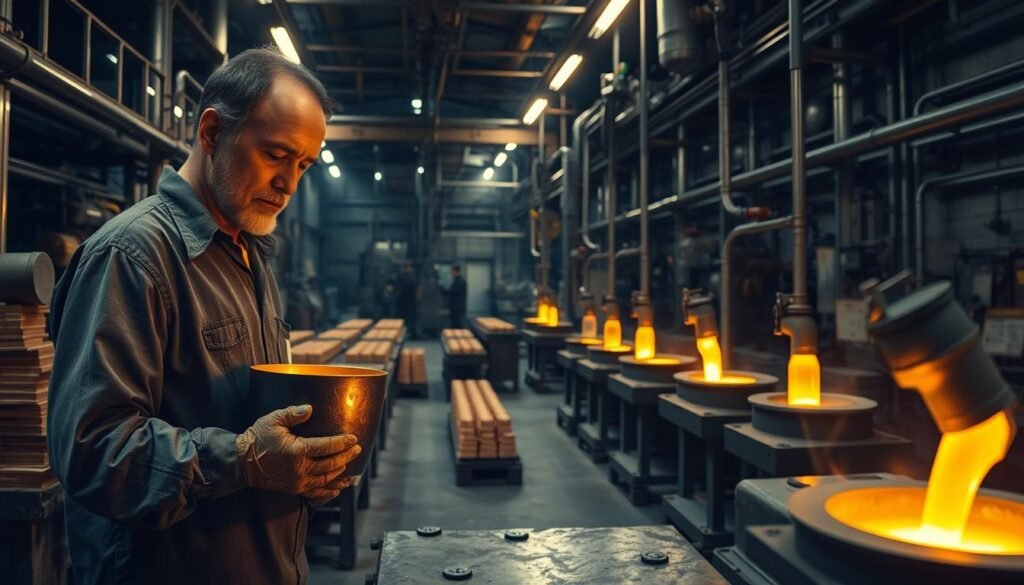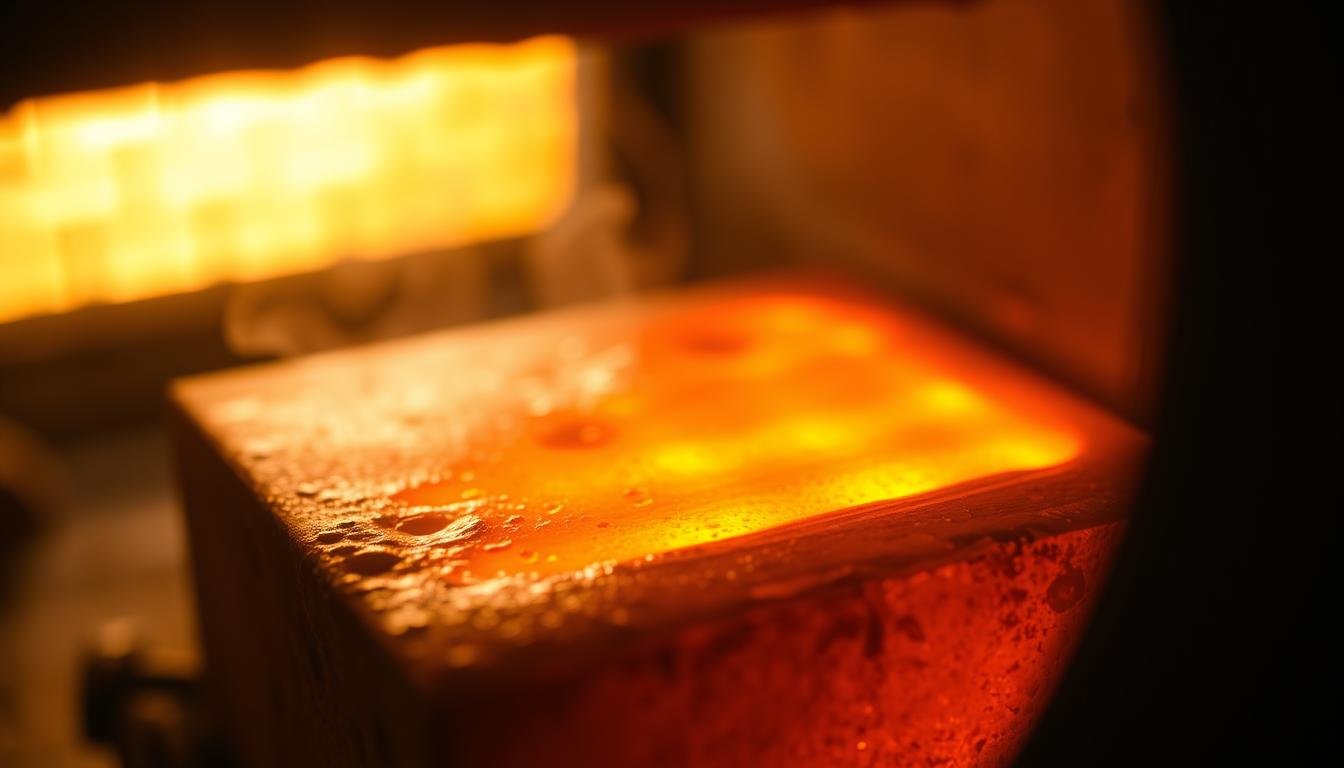Every metalworker knows that thermal behavior defines success in manufacturing. When working with copper-zinc alloys, precise temperature control separates functional components from costly failures. This guide reveals why thermal thresholds matter in industrial applications.
Copper-based alloys transition between solid and liquid states within specific heat ranges. These thresholds determine casting quality, welding efficiency, and equipment durability. Understanding these parameters prevents material waste and ensures workplace safety in foundries nationwide.
Why does composition matter? Variations in elemental ratios alter thermal characteristics significantly. A 10% zinc increase can lower phase-change thresholds by over 90°C (194°F). This knowledge helps engineers select optimal alloys for automotive parts, plumbing fixtures, and musical instruments.
Modern manufacturers rely on accurate thermal data to streamline production. Proper heat management reduces energy costs and extends tooling lifespan. Our analysis provides actionable insights for professionals shaping America’s industrial landscape.
Overview of Brass Melting Point
Precision in thermal processing separates expert craftsmanship from amateur attempts. Copper-zinc alloys behave unpredictably without accurate heat management, making temperature knowledge essential for industrial success. These materials transform under heat in ways that demand both technical understanding and practical skill.
What Determines Phase Transition?
Metallic bonds weaken as heat increases, creating a sliding scale rather than an instant change. For example, alloys with 5% zinc soften near 875°C, while those containing 45% zinc liquefy around 740°C. This variability stems from atomic interactions between primary elements.
Industrial Process Optimization
Foundries rely on precise thermal data to prevent structural flaws in cast components. Overheating degrades surface finishes, while insufficient heat causes incomplete mold filling. Proper furnace calibration maintains material integrity during forging or welding operations.
Temperature control systems account for alloy-specific behaviors, ensuring efficient energy use and worker safety. Modern facilities combine this knowledge with advanced instrumentation to achieve repeatable results across production cycles.
Understanding Brass Composition and Its Properties
Metal alloys derive their unique characteristics from precise elemental combinations. In copper-zinc blends, even minor ratio adjustments create distinct performance advantages for industrial applications. This balance determines everything from thermal thresholds to structural resilience.
Copper and Zinc Ratios
Engineers typically use blends containing 62-75% copper for optimal thermal stability. These mixtures maintain structural integrity up to 967°F while remaining workable for casting. Higher zinc concentrations (above 30%) lower heat tolerance but improve machining efficiency for complex components.
Architectural applications often require 60% copper alloys for their corrosion resistance. Automotive systems benefit from 70% copper ratios that withstand engine heat cycles. Each percentage shift impacts durability and manufacturing costs.
Additional Alloying Elements and Their Effects
Strategic additives transform base copper-zinc mixtures into specialized materials. Lead (up to 3.5%) enhances cutting precision for intricate parts. Aluminum additions boost saltwater corrosion resistance, making these alloys ideal for marine hardware.
Manganese increases tensile strength in load-bearing components, while silicon improves fluidity during casting. These modifications allow manufacturers to customize alloys for specific temperature ranges and mechanical demands without compromising production efficiency.
How to Determine the Brass Melting Point
Accurate thermal analysis forms the backbone of modern metallurgical processes. Professionals use advanced techniques to identify phase-change thresholds in metallic mixtures. These measurements guide critical decisions in automotive manufacturing, aerospace engineering, and architectural design.
Experimental Methods and Instrumentation
Modern laboratories employ three primary tools for thermal analysis:
- Differential thermal analyzers tracking heat flow variations
- Precision calorimeters measuring energy absorption
- Computer-controlled furnaces with ±2°C accuracy
These systems detect subtle changes in material behavior during heating cycles. For example, DSC instruments measure energy differences between samples and reference materials. This data pinpoints exact transition temperatures across alloy grades.
Industry Standards and Testing Procedures
Global organizations maintain strict protocols for thermal characterization. ASTM E967 outlines calibration methods for differential scanning equipment. ISO 11357-3 specifies testing conditions for metallic samples.
| Method | Key Features | Compliance Standards |
|---|---|---|
| DTA | Identifies phase transitions | ASTM E794 |
| DSC | Measures enthalpy changes | ISO 11357 |
| Controlled Furnace | Simulates production conditions | SAE J452 |
Proper sample preparation eliminates contamination risks. Technicians follow five-step protocols including surface polishing and mass standardization. Regular equipment audits ensure consistent results across testing facilities.
Factors Influencing the Melting Temperature of Brass
Multiple variables interact to determine thermal thresholds in copper-zinc alloys. Foundry operators must account for material purity, environmental conditions, and physical transformations during heating cycles. These elements collectively influence phase transitions in industrial applications.
Impurities and Alloy Composition Impact
Foreign particles as small as 0.5% alter thermal behavior dramatically. Lead or aluminum additives modify atomic bonding patterns, creating localized weak points. This disruption lowers the energy required for phase changes.
Secondary elements like silicon or manganese introduce new properties. While improving machinability, they can reduce heat resistance by 12-18% in specific blends. Manufacturers balance these tradeoffs through rigorous material testing.
Grain Structure, Pressure, and External Conditions
Microscopic crystalline arrangements play a surprising role in thermal stability. Fine-grained materials withstand higher heat due to reinforced atomic connections. Coarse structures melt faster under identical conditions.
| Factor | Effect on Melting Temperature | Industrial Consideration |
|---|---|---|
| Atmospheric Pressure | ±25°C per 1 atm change | Vacuum furnace adjustments |
| Grain Size | +40°C for fine structures | Annealing protocols |
| Oxidation Levels | -15°C with surface scaling | Protective gas environments |
Rapid heating rates create uneven thermal distribution, while slow cycles promote oxidation. Experienced technicians monitor these variables using real-time sensors to maintain optimal processing conditions.
Practical Guide for Melting Brass
Industrial workshops achieve consistent results through methodical preparation and controlled thermal management. Proper execution ensures material integrity while optimizing energy use across manufacturing cycles.
Preparation Protocols
Begin by degreasing and sorting scrap materials. Remove paint, oils, or dirt using alkaline solutions or mechanical abrasion. Contaminants as small as 0.2% can create porosity in finished products.
Select furnace types based on production needs:
- Induction systems for rapid heating cycles
- Reverberatory models for large batches
- Electric arc units for precision temperature control
Thermal Transformation Steps
Charge cleaned materials into preheated chambers. Gradually increase heat input to 1,650°F while monitoring with infrared sensors. Experienced technicians recommend:
“Maintain a 50°F buffer below maximum thresholds to prevent zinc vaporization.”
Introduce fluxing agents like borax at 1,200°F to separate impurities. Skim surface dross before transferring the liquid alloy to preheated molds. Allow 15-20 minutes for proper solidification based on component thickness.
Post-processing includes ultrasonic testing and hardness verification. These quality checks ensure cast components meet ASTM B584 specifications for industrial applications.
Safety Considerations When Working with High Temperatures
Worker protection remains paramount in industrial settings with extreme heat conditions. Proper protocols reduce injury risks while maintaining operational efficiency in thermal processing environments. Facilities handling heated materials require tailored safety systems to address unique hazards.
Protective Gear and Workplace Safety
Specialized equipment forms the first defense against thermal hazards. Heat-resistant gloves and full-face shields protect against splashes exceeding 1,000°F. Respirators with HEPA filters prevent inhalation of zinc oxide fumes during material processing.
Workspaces need clearly marked zones around heating equipment. Industrial ventilation systems should achieve 10-12 air changes per hour. Fire extinguishers rated for metal fires must be accessible within 25 feet of workstations.
Handling Hot Metals and Emergency Procedures
Trained personnel use insulated tongs and crucible lifts for material transfers. Facilities implement strict “no solo work” policies near molten materials. Emergency showers and eye wash stations require monthly functionality checks.
Standardized response plans address critical scenarios:
- Evacuation routes for spill incidents
- First-aid protocols for thermal burns
- Immediate power cutoff procedures
“Regular drills cut emergency response times by 40% in foundry environments.”
Thermal imaging cameras monitor equipment surfaces, while automated alarms trigger at preset temperature thresholds. These measures create safer workplaces without sacrificing production speed.
Comparison of Brass Melting Point with Other Metals
Material selection in manufacturing hinges on understanding thermal thresholds across different metals. Engineers balance energy costs, structural needs, and production efficiency when choosing alloys. This analysis highlights how melting points of common metals influence industrial decisions.
Thermal Thresholds: Copper-Zinc Alloys vs. Pure Metals
Copper-based alloys melt at 930°C – 154°C lower than pure copper. This gap allows faster casting cycles while maintaining corrosion resistance. Aluminum’s 660°C phase-change temperature makes it ideal for lightweight components but limits high-heat applications.
| Metal | Melting Point (°C) | Common Applications |
|---|---|---|
| Brass | 930 | Musical instruments, plumbing fittings |
| Copper | 1084 | Electrical wiring, heat exchangers |
| Aluminum | 660 | Aircraft parts, packaging |
| Steel | 1425-1540 | Structural beams, machinery |
Application-Specific Material Choices
Decorative hardware often uses copper-zinc alloys for their golden finish and moderate heat resistance. Electrical systems require pure copper’s superior conductivity despite higher energy demands. Aerospace engineers favor aluminum for its 40% weight savings over steel.
Automotive manufacturers face unique tradeoffs. Radiator cores need aluminum’s low mass, while fuel line fittings demand brass’s durability. As one metallurgist notes: “The right alloy reduces production costs by 18-22% in high-volume operations.”
Optimizing Brass Melting for Manufacturing Applications
Industrial efficiency hinges on smart thermal management strategies during metal processing. Advanced techniques now allow factories to reduce energy costs while maintaining strict quality standards. These methods balance production speed with material integrity across various industrial uses.

Energy Efficiency and Quality Control Measures
Modern facilities achieve energy savings through three key approaches:
- Computer-controlled heating systems maintaining ±5°C accuracy
- Waste heat recapture units reducing fuel needs by 18%
- Real-time composition analyzers preventing material waste
Quality teams implement automated inspection systems that detect flaws during liquid metal transfer. Infrared cameras track temperature gradients, while spectral analyzers verify alloy ratios every 90 seconds. This dual focus cuts defect rates by 27% in automotive part production.
Best Practices and Industrial Tips
Seasoned operators recommend monthly furnace inspections and calibrated thermocouple replacements. Proper crucible preheating prevents thermal shock, extending equipment lifespan. “Documenting every batch’s parameters creates actionable data for process refinement,” notes a leading plant supervisor.
Key operational enhancements include:
- Staged material charging to maintain heat consistency
- Nitrogen atmosphere controls minimizing oxidation
- Preventive maintenance schedules for burners and linings
These strategies help manufacturers meet rising demand while adhering to environmental regulations. Combined with staff training programs, they form the backbone of sustainable metal processing operations.
Conclusion
Mastering thermal thresholds in manufacturing requires precision and expertise. Copper-zinc blends demonstrate how slight compositional changes impact material behavior under heat. This knowledge directly affects product quality across industries from construction to electronics.
Proper heat management ensures components meet exact specifications. Engineers balance zinc ratios and additives to achieve desired properties while maintaining cost efficiency. These decisions influence everything from energy use to workplace safety protocols.
Understanding phase transitions helps professionals avoid common pitfalls. Knowing melting characteristics prevents structural flaws during casting or welding operations. Modern testing methods provide reliable data for optimizing production workflows.
Effective temperature control remains vital for sustainable manufacturing. By applying these principles, industries reduce waste and enhance product longevity. This expertise drives innovation in material science and engineering solutions nationwide.
